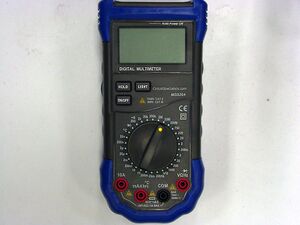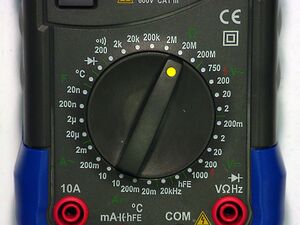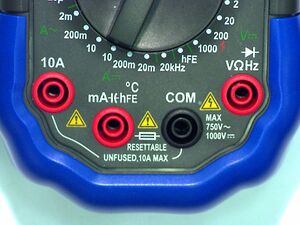Difference between revisions of "MS8264"
| Line 13: | Line 13: | ||
== Use == | == Use == | ||
| − | [[Image: | + | [[Image:MS8264_Dial.jpg|thumb|Dials on MS8264 Digital Multimeter]] |
[[Image:MS8264_Terminals.jpg|thumb|Terminals on MS8264 Digital Multimeter]] | [[Image:MS8264_Terminals.jpg|thumb|Terminals on MS8264 Digital Multimeter]] | ||
To use the DMM, first set the dial (picture at top right) to both the quantity and the range desired. From the top going clockwise, the measurements that can be taken are resistance (<math>\Omega</math>), AC voltage (V~), DC voltage (V-), transistor testing (hFE), frequency (20 kHz), DC current (AC-), AC current (A~), capacitance (F), temperature (deg. C) and diode test (diode symbol). Note that within most of these, several maximum values are selected; choose the setting that gives the greatest precision for your measurement. For example, measuring DC voltages that should peak at 5 V would mean choosing the DC Voltage 20 setting, since 2 is too small and 200 is larger than it needs to be. | To use the DMM, first set the dial (picture at top right) to both the quantity and the range desired. From the top going clockwise, the measurements that can be taken are resistance (<math>\Omega</math>), AC voltage (V~), DC voltage (V-), transistor testing (hFE), frequency (20 kHz), DC current (AC-), AC current (A~), capacitance (F), temperature (deg. C) and diode test (diode symbol). Note that within most of these, several maximum values are selected; choose the setting that gives the greatest precision for your measurement. For example, measuring DC voltages that should peak at 5 V would mean choosing the DC Voltage 20 setting, since 2 is too small and 200 is larger than it needs to be. | ||
| − | Second, connect the test probes to the correct terminals (picture at bottom right). The black test probe should always be connected to the black COM terminal. | + | Second, connect the test probes to the correct terminals (picture at bottom right). The black test probe should always be connected to the black COM terminal. |
| − | |||
== Questions == | == Questions == | ||
Revision as of 19:28, 21 January 2009
The MS8264 is a digital multimeter.
Specifications
The following list is taken from Circuit Specialists[1]
- DC Voltage: 1000V
- AC Voltage: 750V
- Temperature:-20°C to 1000°C (32°F to 1832°F)
- Data Hold and Backlight
- Capacitance: 2nF - 20µF
- Resistance: 200Ohm - 200MOhm
- DC Current: 20mA - 10A
- AC Current: 2mA - 10A
Use
To use the DMM, first set the dial (picture at top right) to both the quantity and the range desired. From the top going clockwise, the measurements that can be taken are resistance (\(\Omega\)), AC voltage (V~), DC voltage (V-), transistor testing (hFE), frequency (20 kHz), DC current (AC-), AC current (A~), capacitance (F), temperature (deg. C) and diode test (diode symbol). Note that within most of these, several maximum values are selected; choose the setting that gives the greatest precision for your measurement. For example, measuring DC voltages that should peak at 5 V would mean choosing the DC Voltage 20 setting, since 2 is too small and 200 is larger than it needs to be.
Second, connect the test probes to the correct terminals (picture at bottom right). The black test probe should always be connected to the black COM terminal.
Questions
Post your questions by editing the discussion page of this article. Edit the page, then scroll to the bottom and add a question by putting in the characters *{{Q}}, followed by your question and finally your signature (with four tildes, i.e. ~~~~). Using the {{Q}} will automatically put the page in the category of pages with questions - other editors hoping to help out can then go to that category page to see where the questions are. See the page for Template:Q for details and examples.
External Links
References
- ↑ Low Cost Multi-Function DMM, Circuit Specialists


